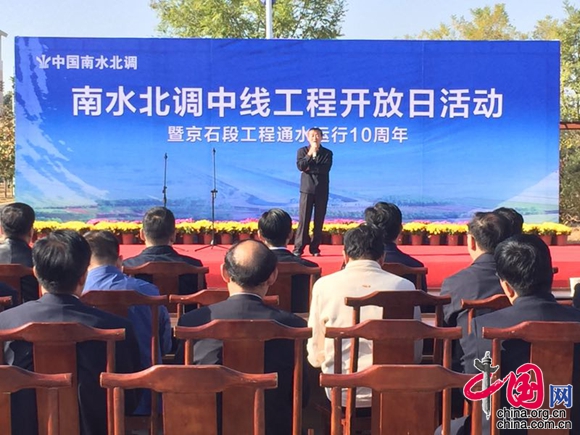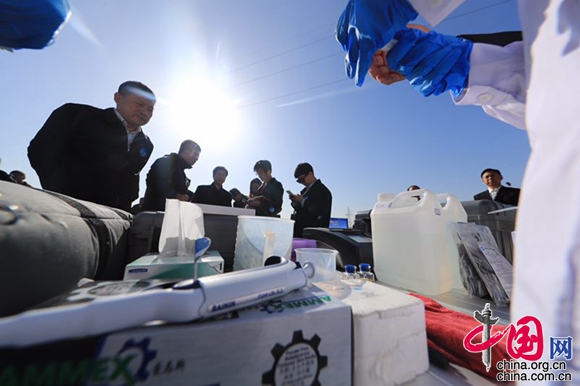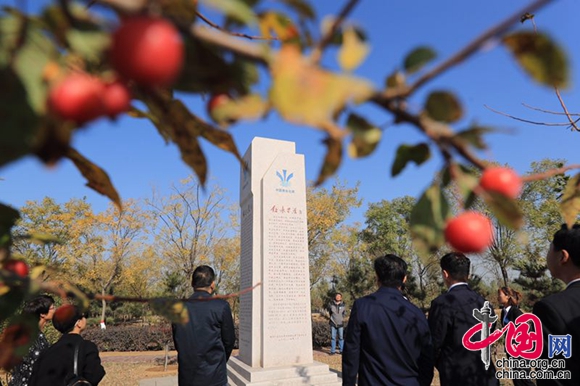Water diversion project holds open day in Hebei
The Hebei Sub-Bureau of the central route of the South-to-North Water Diversion Project hosted the open day in Xinle on Oct. 24. The event hosted residents in areas along the central route, project builders, and staff from other project units.
The Hebei Sub-Bureau of the central route of the South-to-North Water Diversion Project hosted the open day in Xinle on Oct. 24. The event hosted residents in areas along the central route, project builders, and staff from other project units.

Since Dec. 12, 2014, when the central route of the South-to-North Water Diversion Project was put into operation, 3.3 billion cubic meters of water has been diverted to Hebei province, with the water quality reaching the standard of Class II or better. The receiving area covers nearly 100 cities, counties and districts, including Handan, Xingtai, Shijiazhuang, Baoding, Cangzhou, Hengshui and Langfang, benefiting 15.47 million people living in urban and rural areas. The project has been providing a stable water resource for the economic and social development of the areas along the route.

The project's central route ensures the safety of water supply in the receiving areas and provides a strong support for green development. Water shortage is alleviated, and the groundwater level has risen remarkably. More than 5 million people in the Heilonggang areas of Hebei province have bid farewell to high-fluorine water and bitter brackish water. Through the expansion of the scope of direct water supply, water from the Yangtze River is provided to industrial parks and major water users, such as Great Wall Automobile and Junlebao Dairy.

The main canal of the central route forms a clear water corridor in Hebei province that is 465 kilometers long and several tens of meters wide. The 2056 kilometer-long section of the project within Hebei province also forms a network system for supplying and replenishing water to the receiving areas. It provides strong water security for the coordinated development of Beijing-Tianjin-Hebei and the construction of Xiongan New Area. The project is playing a strategic role in China's infrastructure construction.
The central route also helps the construction of ecological civilization in the water receiving areas and provides abundant water resources for ecological restoration. From April to June this year, the central route supplied 351 million cubic meters to Hebei province. Particularly, 112 million cubic meters was supplied to Baiyangdian Lake, and the water quality and ecological environment have notably improved. Through the Fuyang River in Handan and the Hutuo River in Shijiazhuang, mechanics are testing the comprehensive treatment of groundwater over-exploitation and replenishment of groundwater, and they estimate that 550 to 850 million cubic meters of water could be supplied annually.

Under the strong leadership of the Construction Administration Bureau of the Central Route of the South-to-North Water Diversion Project, the Hebei Sub-Bureau has put forth solid efforts to construct and manage the project. The sub-bureau has done a remarkable job in water transfer, water quality protection, and safety guarantee. By setting up a standardized and intelligent management system, the sub-bureau has firmly built a “firewall” to ensure safe water supply, guarding the water lifeline of Beijing.
On Sept. 18, 2008, the Beijing-Shijiazhuang section of the central route of the South-to-North Water Diversion Project began to supply water to Beijing through the diversion of water from four reservoirs in Huangbizhuang, Gangnan, Wangkuai, and Angezhuang in Hebei province. Over the past 10 years, 1.61 billion cubic meters of water was transferred from the Beijing-Shijiazhuang section, effectively alleviating water shortage in Beijing.

